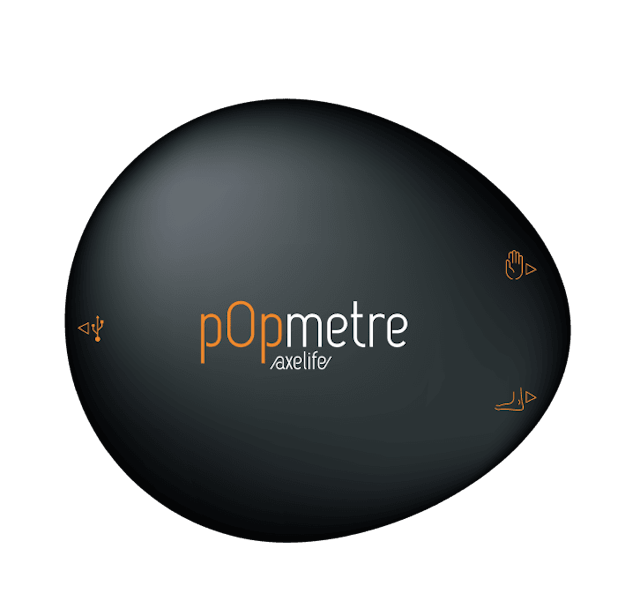What is blood pressure ?
Over time, the techniques used to analyze arterial pulse and its characteristics have evolved from simple tactile assessment to complex methodologies such as ultrasound and photoplethysmography (PPG). Current understanding of various arterial pulse characteristics is based on the observations and experiences of our ancestors. Scientific advancements continue to lead to significant progress in our knowledge of arterial pulse and its applications in diagnosing atherosclerotic disease and many other therapeutic areas.
The 20th century was marked by the rise in the understanding of blood pressure.
The history of research on arterial pulse takes us far back in time, with early writings dating to ancient Egyptian and Greek civilizations. The first advancements regarding the pulse wave are attributed first to William Harvey, an English physician from the 17th century, and then to the development of the first measuring devices starting from the 19th century. First came Jules Hérisson's Sphygmometer, followed by the Kymograph by the German Carl Ludwig, and finally, Etienne Marey's Sphygmograph...
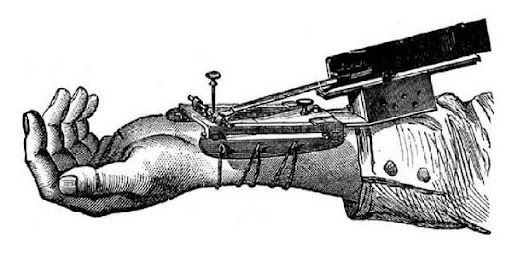
The first formal study on the arterial pulse wave was conducted by Marey using his sphygmograph. He described the differences in arterial pulse waveforms between older and younger adults. The initial recordings of pulse waves were made possible at that time, although they were not necessarily very relevant.
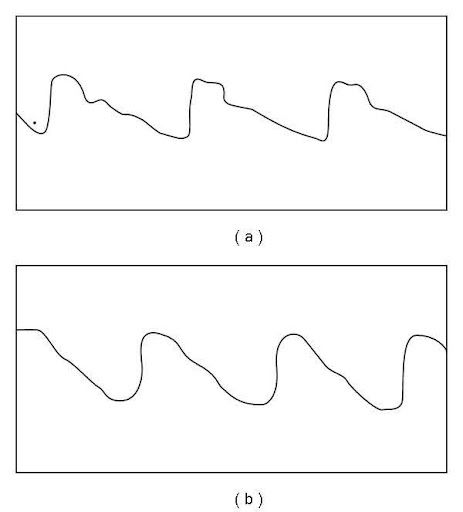
The Mahomed sphygmograph, which had the capability to quantitatively record the pressure of the arterial pulse wave, led to the introduction of the sphygmomanometer in the late 19th century, especially the cuff sphygmomanometer by Postel-Vinay in 1896. This was the precursor to the modern blood pressure monitor used by doctors worldwide to measure peripheral blood pressure. In 1896, the Italian physician Scipione Riva Rocci further developed the sphygmomanometer, taking the final step toward the creation of the blood pressure monitor, an instrument used to measure blood pressure. Later, Nikolaï Korotkov made significant improvements to the device, allowing for the diagnosis of hypertension.
Recording pulse waveforms was initially challenging and time-consuming, often resulting in artifacts in the recordings. The introduction of the cuff simplified interpretation by providing numerical values that reflected cardiac force (systolic pressure) and arteriolar tone (diastolic pressure). It took 50 years for the first blood pressure guidelines for hypertension to be established by the World Health Organization (WHO) after World War II, and nearly 100 years for them to be adopted in France under the guidance of ANAES in 1997. Therefore, it took 100 years for the blood pressure monitor to become an established tool for measuring blood pressure.
However, measuring blood pressure alone is not sufficient to detect underlying arterial damage, as elevated blood pressure is a measurable symptom of underlying cardiovascular disease. Vascular, cardiac, cerebral, and renal abnormalities often appear dissociated from blood pressure readings. Increased arterial stiffness is an independent risk marker and may be more sensitive for detecting arterial damage than simple blood pressure measurement. Measuring pulse wave velocity, which corresponds to the propagation of the pressure wave generated by the heart's contraction along the arteries, has quickly become the "gold standard" for assessing arterial stiffness.
Pulse Wave Velocity: Cardiovascular Biomarker of the 21st Century?
The pulse wave corresponds to the sudden increase in blood volume at the exit of the left ventricle.

The pulse wave is a pressure wave that propagates along the arteries at a speed ranging from 4/5 to 10/12 m/s depending on an individual's age.
The value of pulse wave velocity (PWV) allows for the quantification of arterial stiffness and thus provides healthcare professionals with a marker of cardiovascular health. The arterial wall thickens and stiffens with age. These structural and functional changes related to aging are not distributed uniformly but are more pronounced in the aorta and central elastic arteries. Furthermore, the mechanisms linking arterial stiffness and vascular disease (e.g., atherosclerosis) are not fully understood. In addition to being a marker of cardiovascular aging, aortic stiffness has been independently associated with an increased cardiovascular risk of morbidity and mortality.

Source: https://pubmed.ncbi.nlm.nih.gov/25170513/ Hence the importance of assessing arterial stiffness in clinical practice.
PWV, a marker of arterial flexibility
PWV (Pulse Wave Velocity) was recognized in 1922 as a marker of arterial elasticity and a fundamental index of "circulatory efficiency" by Bramwell and Hill (Bramwell and Hill, 1922). However, the concept of analyzing arterial waves and evaluating arterial pulse has been known since the end of the Han Dynasty (Parker, 2009) when one of the first books, "The Pulse Classic (Mai Jing - the Treatise on Pulses)," was written in 220 AD. Furthermore, the concept of pulse wave transmission forward was identified by Erasistratos as early as 280 BC, and he discovered that the pulse appeared earlier in arteries proximal to the heart than in those distal to the heart (Skalak et al., 1981).
Crighton Bramwell, a scientist from the early 20th century, was the first to introduce the concept of Pulse Wave Velocity (PWV).
He described the velocity as varying proportionally with arterial wall tension and blood pressure and as an indirect measure of arterial wall elasticity. Bramwell and Hill introduced a simple formula by which arterial elasticity could be calculated from PWV. With this formula, he found a positive correlation between PWV and age and a negative correlation between arterial wall elasticity and PWV. Pulse Wave Velocity (PWV) is actually a measurable, finite value that varies along the arterial tree (4 to 5 m/s in the aorta, 8 to 9 m/s in the iliac arteries), depending on the compliance of the considered arterial segment. PWV quickly emerged as the "gold standard" for measuring arterial stiffness.
The link between arterial compliance and PWV
To understand the link between arterial compliance and PWV and to analyze the pulse wave, including measuring central aortic pressure, it was necessary to develop mathematical and algorithmic approaches. There exists a relationship between arterial compliance and PWV (Bramwell and Hill equation).

Where ρ is the blood density, V dP/dV is the inverse of compliance. Since the invention of the plethysmograph by Schmitt in the mid-20th century, studies on the pulse wave have progressed at a faster pace.
Several methods have been used over the last fifty years for the study of PWV, such as hot-wire sphygmography, impedance plethysmography, applanation tonometry, and pulse wave recording using crystal microphones.
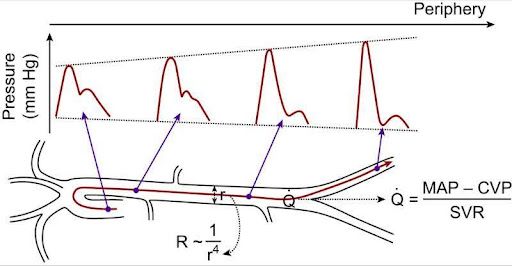
Gradually, studies on PWV transitioned from peripheral circulation to more reliable assessments of central circulation. Researchers began to study the characteristics of pulse waves in the abdominal aorta primarily because they were more reliable, less variable, and more easily reproducible. By using plethysmography to record hemodynamics in the abdominal aorta, aortic PWV proved to be an important surrogate for coronary vascular system stiffness. Asmar et al. In a study of 56 subjects, compared a new automated device with manual calculation for PWV determination and found that the results of both were very close and reproducible. This discovery led to the development of three automated devices: Complior (Artech Medical, Pantin, France), Arteriograph (TensioMed, Budapest, Hungary), and Sphygmocor (AtCor Medical, Sydney, Australia). The latter is considered the "gold standard," the reference. In any case, it is the one that has been accompanied by the most clinical studies in the field.
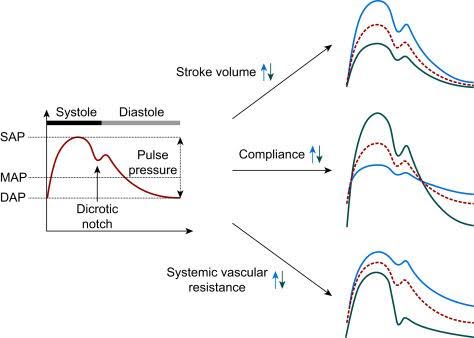
The measurement of Pulse Wave Velocity
Other non-invasive methods such as ultrasound and magnetic resonance imaging have also been introduced for PWV measurement. Using ultrasound, aortic PWV has been shown to be an independent predictor of cardiovascular risk. There are several mathematical approaches to measure PWV and arterial stiffness. In this publication, the author describes them while emphasizing, "The most sacred (and still probably the best) measure of arterial stiffness is Pulse Wave Velocity (PWV). This quantity is related to the Young's modulus (E) of a thin-walled, homogeneous elastic tube by the formula: , where ρ is the fluid density inside (blood is about 1.05) and h/2r is the wall thickness/diameter."

Pulse Wave Velocity is measured as the difference between two recording sites in the pulse wave propagation path and the delay between corresponding points on the wave (pressure or flow), which are not influenced by wave reflection. The wavefront or initial upstroke is the usual reference point in both waveforms.
Pulse Wave Velocity is a recent biomarker developed at the end of the 20th century and validated through more than 2,000 studies per year since the early 2000s. These developments have allowed for the evolution of measurement techniques that facilitate the transition from clinical settings to practical use in better evaluating patients' cardiovascular health during consultations. Axelife, by developing a medical device that measures finger-to-toe PWV through photoplethysmography technology, has developed unique algorithmic expertise in pulse wave analysis, enabling it to calculate central pressures and AIx. pOpmètre® is a non-invasive, operator-independent medical device with good reproducibility that measures PWV, the gold standard for arterial stiffness measurement. In an article titled 'We Have the Age of Our Arteries, But No One Wants to Know. It's Time for That to Change!' Professor Boutouyrie, a cardiologist at HEGP and a reference in the field of arterial stiffness, concludes by stating, 'In an ideal world, the beginning of the 21st century should mark the disappearance of the blood pressure cuff. We are in the home stretch.' You have the age of your arteries, and with pOpmètre®, you can now measure it."
